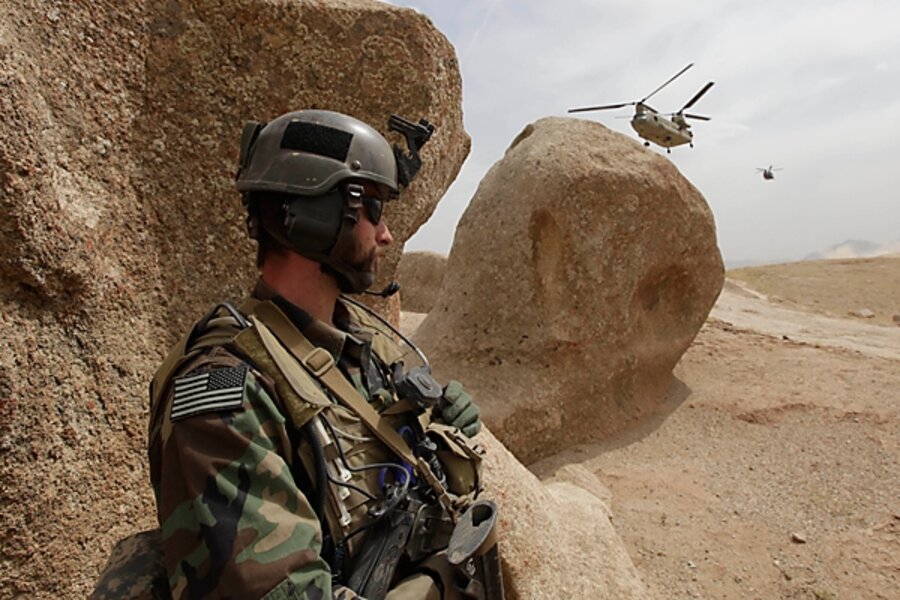How can 40,000 troops fix chronic corruption in Afghanistan?
Loading...
Comments by President Obama and his advisers this week suggest that the administration is slowly coming to the conclusion that the Afghan government – and not the Taliban – is perhaps the most serious impediment to progress in Afghanistan.
The US commander in Afghanistan, Gen. Stanley McChrystal, has essentially told Mr. Obama that the US must repeat an Iraq-style surge in Afghanistan – adding 40,000 troops to the 21,000 Obama has already sent – to succeed.
Yet the administration isn’t even debating this request yet. Defense Secretary Robert Gates said Sunday that he will leave McChystal’s troop request behind when he attends a series of White House meetings beginning this week about the way forward in Afghanistan.
The reason is that the main concern now is not military. It is political.
Is the Afghan government reliable?
After the surge in Iraq, McChrystal, Obama, and the administration can be reasonably confident that the US military has the intelligence and adaptability to fight a successful counterinsurgency in Afghanistan.
The concern is that the Afghan government has become so rotted with corruption that it cannot consolidate the gains the US military makes. In other words, the US will never be able to leave Afghanistan unless there's at least a minimally effective government to help in the near term and then take over in the future.
Former President Clinton put it this way on NBC’s “Meet the Press” Sunday: “To succeed, there needs to be a partner.”
Doubt over that point, more than anything else, appears to be driving Obama’s review.
On ABC’s “This Week,” Secretary Gates said Obama always intended to “reassess where were are” after the Afghan presidential election. But allegations of widespread fraud have turned that reassessment into a full-blown crossroads moment.
Election was the last straw
The doubts are well-founded, though they are not new. Analysts have struggled to invent terms to describe the depth of corruption in Afghanistan. One has called it a “narco-kleptocracy,” with government posts on offer to the highest bidder and opium money fueling corruption on a massive scale.
The US Drug Enforcement Administration has accused Afghan President Hamid Karzai’s brother, Ahmed Wali, of running the opium trade in Kandahar Province.
Law and order in the country has collapsed as many police use their posts primarily as a platform for bribe-taking.
Even before the election, President Karzai had lost broad public support in Afghanistan because of his government’s inability – or unwillingness – to stifle corruption. Indeed, it is corruption, not insecurity, that most angers Afghans.
Yet the reports of fraud from the Aug. 20 election were apparently too much for the Obama administration to ignore.
Secretary of State Hillary Rodham Clinton said on CBS’s “Face the Nation” Sunday that she will wait until all the allegations of fraud are dealt with, and then deliver a stern lecture.
“Once the election is finished, we are going to impress upon the new government what is expected of them,” she said.
McChrystal's plan
Though it has garnered relatively little attention, McCrystal made fighting corruption a top priority of his assessment. He broke down his new Afghan strategy into four points. No. 2 was “prioritize responsive and accountable governance” – above any operational changes (No. 3), or resources (No. 4), and below only the building up of Afghan security forces.
In his assessment, he writes of Afghanistan’s most powerful political figures: “Some of these major power brokers hold positions in the ANSF [Afghan National Security Forces], particularly the ANP [Afghan National Police], and have been major agents of corruption and illicit [opium] trafficking.”
In a statement demonstrating the depth of the problem, he continues: “There are no clear lines separating insurgent groups, criminal networks (including the narcotics networks), and corrupt [government] officials.”
To McChrystal, his strategy includes an anticorruption element. He wants to use the 40,000 additional troops to protect Afghans from all threats – including their own government. NATO “can no longer ignore or tacitly accept abuse of power, corruption, or marginalization,” he writes.
In coming weeks, it seems, Obama will be deciding whether McChrystal is the man to bring the Afghan government back from the brink or if Kabul is now too rotten to be trusted.
"If Karzai doesn't shape up, there's a question of whether anything can be accomplished in Afghanistan," said Sen. Dianne Feinstein (D) of California on Fox News Sunday.
-----
Follow us on Twitter.





